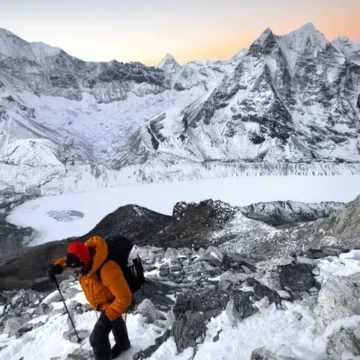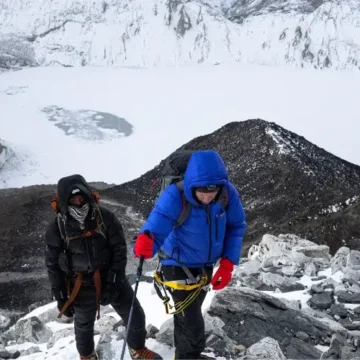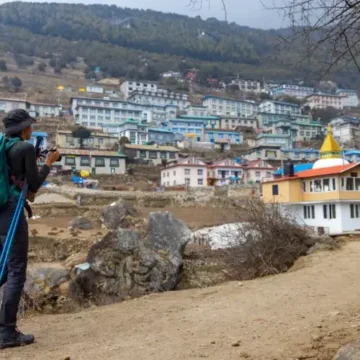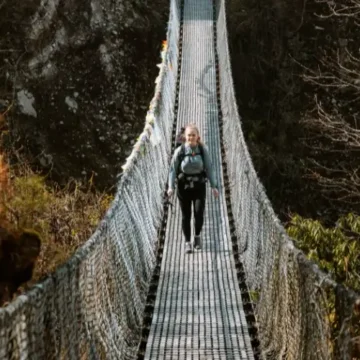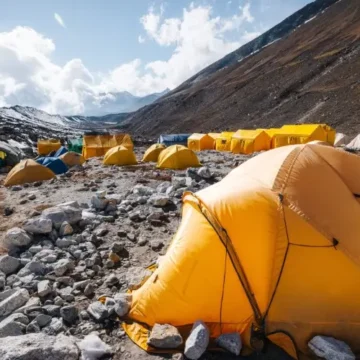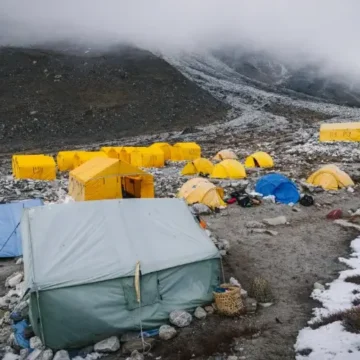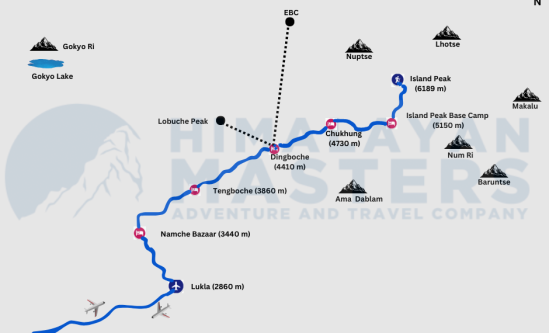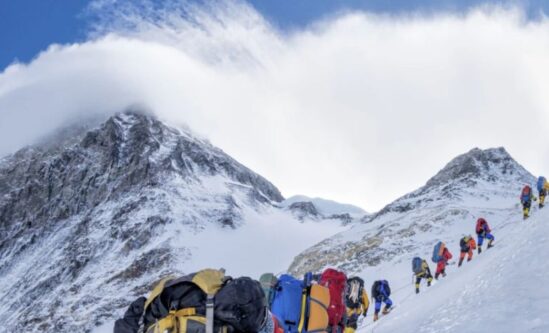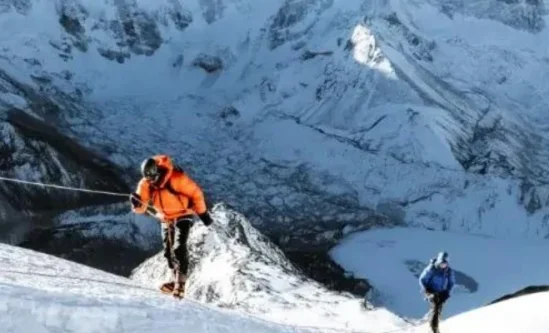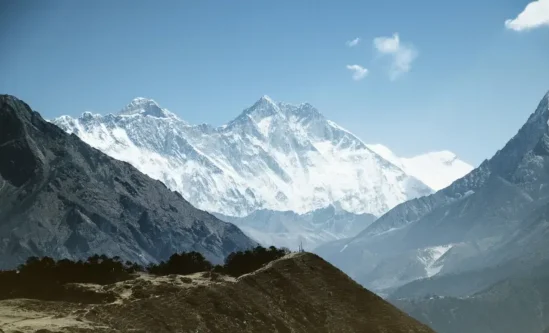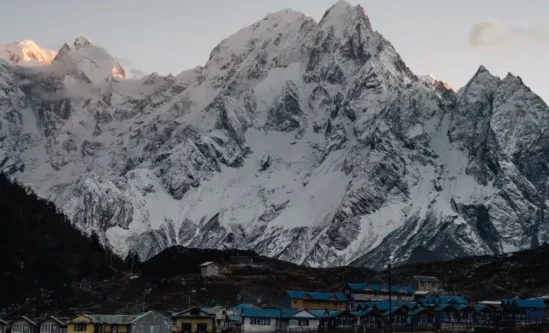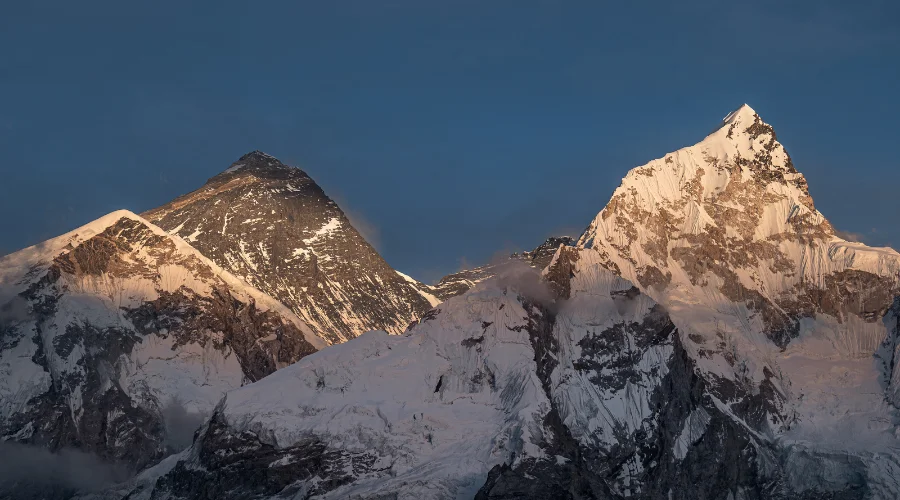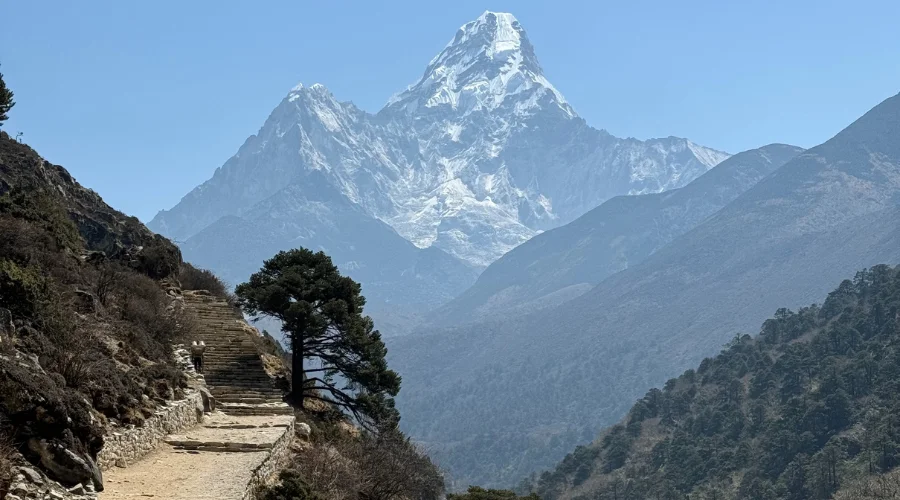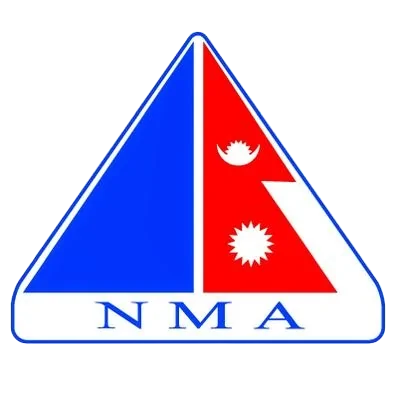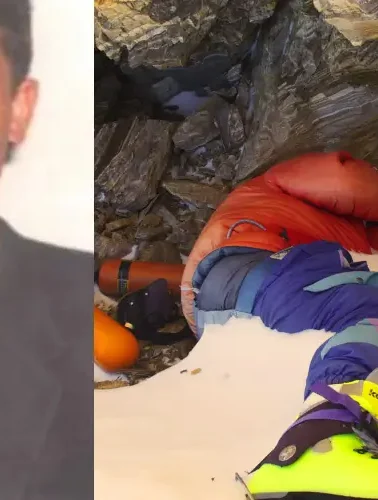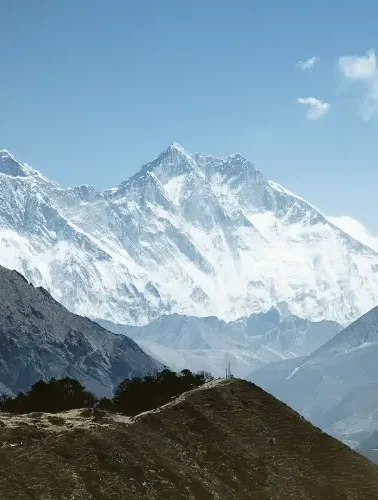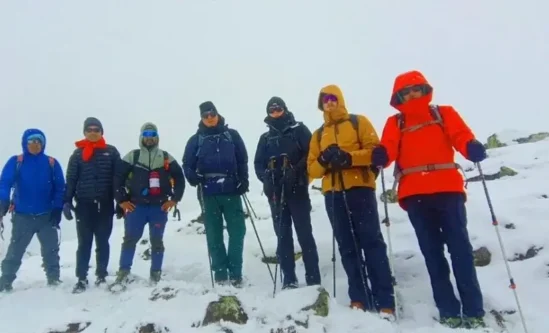
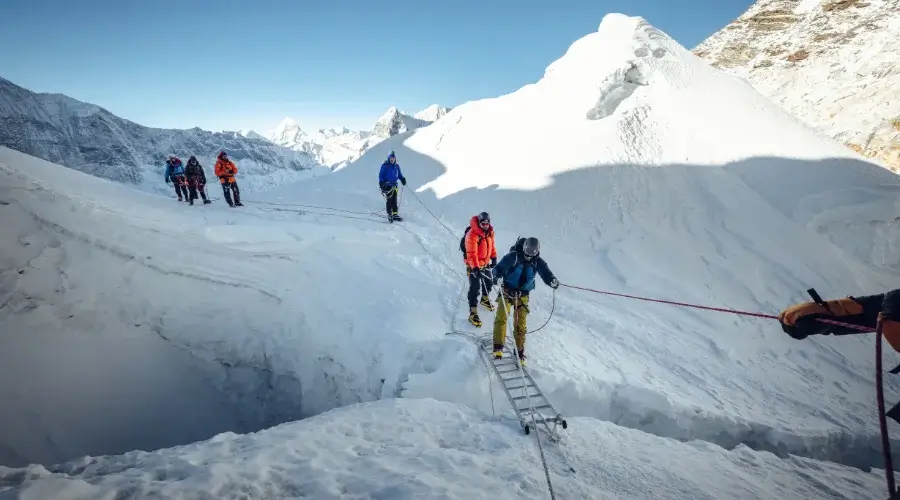
- TRIP DURATION
- 13 Days
- MAX. ALTITUDE
- 6189 m/ 20305 ft.
- TRIP GRADE
- Hard
- LODGING
- Hotel, Tea House & Tent
- BEST SEASON
- Springs and Autumn
- MEALS
- Breakfast, Lunch & Dinner
- COMMUNICATION
- Wi-Fi/ Local SIM Card
- PER DAY WALK
- 5 to 6 Hours
Island Peak Climbing
Island Peak, also known as Imja Tse, is one of Nepal’s most famous trekking peaks. It is situated in the Everest area and has an altitude of 6,189 meters or 20,305 feet. It is considered one of the more exciting climbs for everyone who loves adventure. Today, it is ideal for beginners who wish to taste Himalayan adventures without requiring high-level technical expertise.
Island Peak Climb is usually done together with the Everest Base Camp trek. This means that trekkers can enjoy the views of both trekking and climbing in one session. The climb takes one through beautiful Sherpa country, old monasteries, and superb scenery with towering peaks.
Despite rather steep passages, lengths of rope, crampons, and other amenities –Island Peak is reasonably feasible for experienced trekkers with an appropriate physical fitness level and a decent knowledge of mountaineering. At base camp, acclimatization sessions prepare the climbers for the last stand.
Failure may be bitter, but success is worth it, especially when you get to the top of a hill. Trekkers are rewarded with incredible views of some of the tallest Mountains on the planet: Lhotse, Nuptse, and Mount Everest. Some climbers found the push-up to the summit very rewarding, and the views around Island Peak make a logical and fulfilling climax for any adventure lover desiring to conquer the Himalayas.
Island Peak Climb Routes/ Ridges
South Ridge
Island Peak’s base camp is located at Pareshaya Gyab, at an altitude of 5,150m, between Imja Tse and Imja Glacier. Although the base camp is an excellent place for climbing preparation, climbers prefer to settle at the high camp. Walking along the broad, open gully leading to the high camp is an effortless journey. From there, the challenging climb, along with the steep snow and ice ramps, finally leads to the summit.
North Ridge Route
The first climb to the island peak from the northern ridge was done in 1958. This route, discovered by the team of two Sherpas, Alf Gregory and Dick Cook, climbs from the height above the col. Getting on the right bank of the Imja Glacier, we move above Lhotse Sar Glacier. Finally, rising to the northwest over snowy slopes, we continue to the south and reach the final summit pyramid. The climbers grade the north ridge route, which is relatively tricky.
Island Peak Climb Facts
- Climbing Beginning Point: Kathmandu
- Climbing Ending Point: Kathmandu
- Peak Climbing Distance: Approximately 100 km (62 miles) round trip
- Maximum Altitude: Island Peak 6,189 meters (20,305 feet)
- Island Peak Base Camp Altitude: 5,200 meters (17,061 feet)
- Climb Duration: 13 days (including acclimatization and climbing days)
- Permits: Sagarmatha National Park Permit, Khumbu Rural Permits and Climbing permit
- Mode of Transportation: Flight and Trek
- Best Time to climb Island Peak: Spring and Autumn
Island Peak Climbing Highlights
- Enjoy a breathtaking flight to and from Lukla.
- Engage yourself in the life of the mountain people.
- Visit this famous Tengboche monastery along the trek.
- Witness remarkable views of the Khumbu Icefall and Makalu Himalayan Range.
- Reach the summit of Island Peak at 6,189 meters (20,299 feet).
- Experience proper acclimatization to high altitudes.
- Receive training in climbing techniques and use of equipment.
- Enjoy panoramic views of major peaks like Lhotse, Nuptse, and Ama Dablam from the summit.
- Visit the Chukung Valley with its amusing 360-degree views of the mountains.
- Trace the classic Everest Base Camp route to visit the Namche Bazaar and the Tengboche Monastery.
Can You See Everest From Island Peak Climbing?
Yes, you can see Mount Everest while climbing Island Peak. Everest becomes visible from Namche and appears large as you move closer to the mountains. Along with Mount Everest, you can witness dozens of other peaks. Here are other peaks you can see during the island peak climb:
- Lhotse (8,501 m/ 27,928 ft)
- Nuptse (7,879 m/ 25,848 ft)
- Lhotse Middle Peak (8,410 m/ 27,605 ft)
- Lhotse Shar (8,383 m/ 27,503 ft)
- Makalu (8,485 m/ 27,838 ft)
- Baruntse (7,129 m/ 23,389 ft)
- Ama Dablam (6,812 m/ 22,349 ft)
Culture and Wildlife in Island Peak
When walking through the Khumbu area, you will feel the impact of Tibetan Buddhism, which is still actively present among the people of the Sherpa ethnicity. Monasteries, prayer flags, and Mani walls are often seen throughout the trail, and there is a way to witness the aspects of local religion.
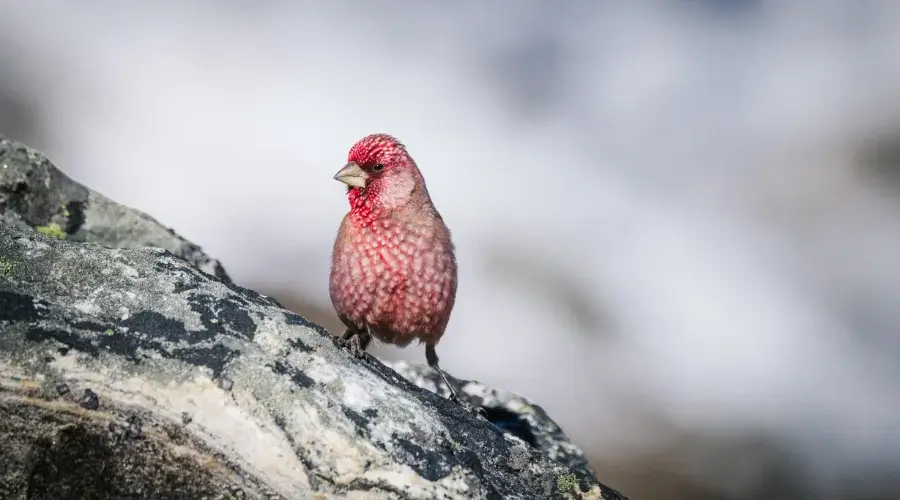
During the tour, you will also meet different types of wild animals. Sagarmatha National Park, which has been on the list of World Heritage Sites, boasts of animals like the Himalayan tahr, snow leopards, although seldom seen, musk deer, birds including Danphe, the national bird of Nepal, and the blood pheasant.
A Typical Day at Island Peak
Each day on the Island Peak climb is scheduled to start early in the morning to maximize good weather fully. You will wake up around 6 or 7.00 AM, gearing up and breakfast. This means that the day begins by hiking towards the next destination.
You are to hike for about 4-6 hours, and you will see mountains, rivers, or valleys. Lunch is often eaten at the teahouse or, conversely, may be taken as a picnic.
In the evening, you will either sit in the car to listen to the guided tour of the day’s stops or take a walk around the areas of interest. You may talk to the people and visit monasteries or some historical attractions.
Dinner is served around 6:00 or 7:00 PM. Then, there is an opportunity to rest, which one may spend playing cards with other climbers or attending a briefing of the following day’s climb.
On summit day, you will wake up in the middle of the night to get the best shot of good weather. You will trek along steep paths, and where necessary, you will require ropes and other tools to get up; you will get to the Island Peak in the early morning. Following this, you will have your victory celebration by going to the peak and returning to base camp.
Documents for Booking
- Valid Passport (6 months validity)
- Nepal Tourist Visa
- Travel Insurance (covering high-altitude trekking)
- Passport-sized Photos
Notes to Remember for Island Peak Climbing
- Carry sufficient water and energy bars for the climb.
- Wear layered clothing to adapt to sudden weather shifts.
- Respect local cultures and traditions during your trek.
- Use eco-friendly products to minimize your environmental impact.
- Follow trail markers and listen to your guide’s instructions.
- Pace yourself steadily to avoid exhaustion.
- Stay prepared for altitude variations and potential altitude sickness.
People Also Like This: How Many Days to Climb Mount Everest?
Climb to Island Peak (Imja Tse) Itinerary Outline
| Day | Itinerary | Sleep Altitude | Distance | Time |
| 01 | Fly to Lukla and trek to Phakding | 2610 m | 144 km | 3 hrs |
| 02 | Trek to Namche | 3440 m | 12 km | 7 hrs |
| 03 | Trek to Tengboche | 3860 m | 6 km | 6 hrs |
| 04 | Trek to Dingboche | 4410 m | 8 km | 7 hrs |
| 05 | Trek to Chhukung | 4730 m | 4 km | 3 hrs |
| 06 | Acclimatization at Chhukung (Pre-climb Training) | 4730 m | – | – |
| 07 | Trek to Island Peak Base Camp | 5080 m | 5.6 km | 4 hrs |
| 08 | Summit to Island Peak & back to Chhukung | 6189 m | 11 km | 11 hrs |
| 09 | Trek back to Dingboche | 4410 m | 4 km | 3 hrs |
| 10 | Trek back to Tengboche | 3860 m | 8 km | 5 hrs |
| 11 | Trek back to Namche | 3440 m | 6 km | 4 hrs |
| 12 | Trek back to Lukla | 2840 m | 18 km | 6 hrs |
| 13 | Fly back to Kathmandu | 1400 m | 138 km | 25 min |
ITINERARY
Day 01: Fly from Kathmandu to Lukla and Trek to Phakding
Trek Route: Lukla → Chheplung → Chauri kharka → Thado Koshi → Phakding
Beginning Point: Kathmandu (1400 m/ 4593 ft.)
Ending Point: Phakding (2610 m / 8563 ft.)
Lukla to Phakding Distance: 5-7 km
Total Ascent: 1210 meters (3969 ft.)
Lunch: Thado Koshigaon
Overnight: Phakding
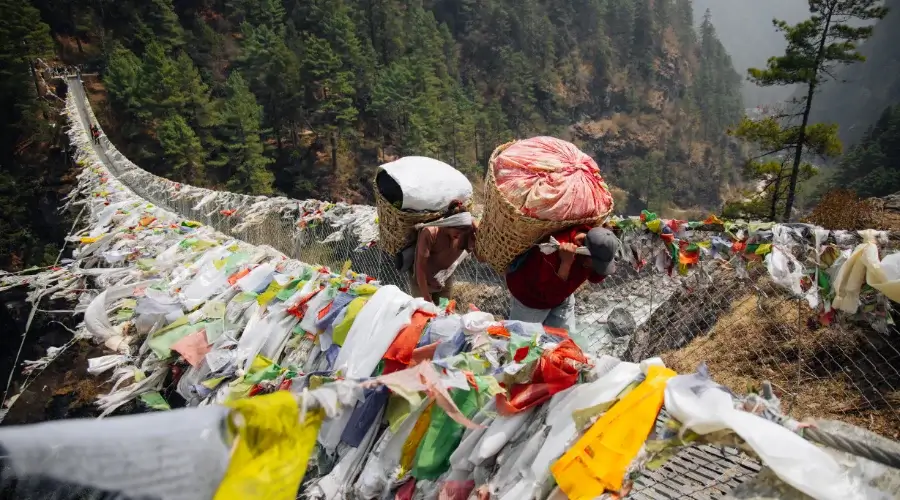
Quite early in the morning, a driver picks us up from the airport and drives us to the domestic airport. On a morning flight, we can see the mountains smiling at us while we land at Lukla Airport at 2,845 meters. We met our sherpas and porters here, starting the trek.
From Lukla, the crew starts the walk via the small villages of Chheplung and Ghat. Walking the route of the Dudh Koshi River, we hike to Sano and Thulo Gumela.
Even on the first day, we witness the monasteries of Drangdrak Gompa and Pema Choling Gompa. After a few hours, we will rest at the tea house in Phakding.
About Phakding:
Phakding is a small village located in the Khumbu region. The locals primarily rely on tourism for their livelihood, offering hospitality services like tea houses. The village is known for its beautiful scenery and proximity to the Dudh Koshi River.
Phakding Tea House Services:
- Several options available (more than 10).
- Twin-sharing rooms with standard amenities; some may offer single rooms upon request.
- Most have attached bathrooms; shared options are also available.
- Hot showers are available, typically at no extra charge.
- Wi-Fi is limited in availability and may not be reliable in remote areas.
Meal : Breakfast, Lunch and Dinner
Accommodation : Tea House
Walking / Driving : 30 min flight and 4 hours trek
Day 02: Trek from Phakding to Namche
Trek route: Phakding → Toktok → Banker → Monjo → Jorshalle → Namche
Beginning Point: Phakding (2610 m / 8563 ft.)
Ending Point: Namche Bazaar (3440 m / 11319 ft.)
Phakding to Namche Distance: 12 km / 7.5 miles
Total Ascent: 830 m (2723 ft.)
Lunch: Jorsalle
Overnight: Namche Bazaar
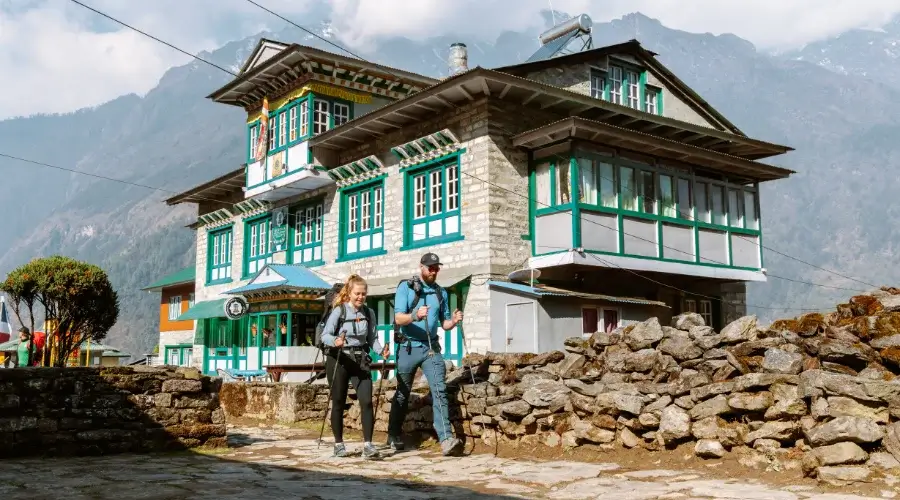
The 2nd day of the trip is an exciting walk through the subtropical forest. It’s your chance to see Nepal’s rear flora and fauna before you get to the alpine grassland.
We also get to cross thrilling suspension bridges like the Hillary Bridge. In Monjo, we stopped to get our permits checked and started climbing upward.
The final tough walk brings us to the Namche bazaar by the evening. This traditional trading town of Khumbu has a lot of restaurants and bars for a wonderful night.
About Namche Bazaar in Brief
The town is known for its colourful markets, where visitors can find everything from trekking gear to local handicrafts. Namche boasts several tea houses, bakeries, and restaurants that offer a variety of cuisines. Namche has around 70-80 normal local people’s houses.
The weekly Saturday market is a highlight, attracting traders from nearby areas and providing an authentic cultural experience.
With stunning views of surrounding peaks like Thamserku and Kongde Ri, Namche Bazaar is a scenic and cultural gem in the Khumbu region.
Namche Tea House Services at Namche:
- There are around 40-50 teahouses.
- Twin-sharing rooms; some tea houses offer single rooms.
- Most have attached bathrooms; shared facilities are common.
- Available at no additional cost in many places.
- Wi-Fi and charging are available in many tea houses.
Meal : Breakfast, Lunch and Dinner
Accommodation : Tea House
Walking / Driving : 7 hours
Day 03: Trek to Tengboche from Namche
Trek route: Namche → Stupa → Kyanjuma → Phunge Thenka → Tengboche
Beginning Point: Namche Bazaar (3440 m / 11319 ft.)
Ending Point: Tengboche (3860 m / 12664 ft.)
Distance: 6 km / 3.7 miles
Total Ascent: 460 m (1509 ft.)
Lunch: Phunke Tenga
Overnight: Tengboche
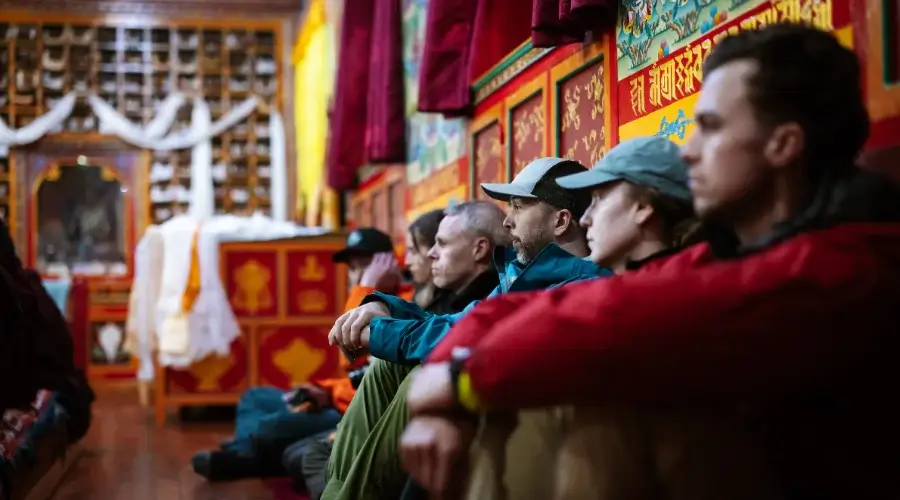
As we hike over the Namche village, we can witness the stunning Everest, Nuptse, and Island peaks. As we walk along the Dude Koshi River, we walk via the thick alpine forests towards the village of Phunge Thenga.
A steep ascent from here takes us to the Tengboche village, the largest and most beautiful monastery in the Khumbu zone. We pray at the monastery and spend a night here during the Island Peak Trek.
About Tengboche:
Tengboche is renowned for its monastery, one of the largest in the Khumbu region. The village offers stunning views of the surrounding peaks and is a spiritual centre for many trekkers.
A monastery that is one of the largest in the Khumbu region and is believed to be 500-600 years old as a spiritual centre for local Sherpas and trekkers alike. The village offers breathtaking views of Mount Everest and Ama Dablam.
Tengboche Tea House Services:
- There are only 5 teahouses.
- Twin-sharing rooms and single rooms may be available but are limited.
- Generally shared bathrooms; few may have attached options.
- Limited availability may not always work well due to the remote location.
- Available during certain hours for charging devices for which you need to pay extra cost.
Meal : Breakfast, Lunch and Dinner
Accommodation : Tea House
Walking / Driving : 6 hours
Day 04: Trek to Dingboche from Tengboche
Trek Route: Tengboche → Dibuche → Pangboche → Somare → Dingboche
Beginning Point: Tengboche (3860 m / 12664 ft.)
Ending Point: Dingboche (4410 m / 14464 ft.)
Tengboche to Dingboche Distance: 8 km / 5 miles
Total Ascent: 550 m
Lunch: Somare
Overnight: Dingboche
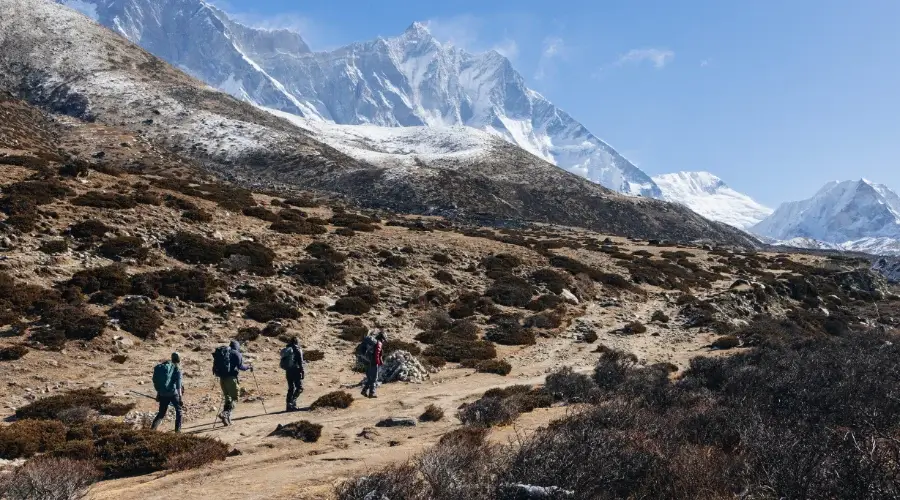
After leaving Tengboche, we will hike via the forested path towards Pangboche. Crossing many chortens and decorations, we enter the Imja Valley.
Then, it’s a short and fun descent before we walk down to the Dingboche village. Dingboche is often a resting place with a better view of the Island and Lhotse Peak for Island Peak Trekking.
About Dingboche:
Dingboche is often used as an acclimatization point due to its elevation. The village has a small community of Sherpas who depend on tourism for their income.
The local Sherpa community engages in agriculture, growing crops like potatoes and barley in terraced fields. Dingboche’s higher altitude provides a unique opportunity to experience life in the Himalayas while preparing for further climbs.
Dingboche Tea House Services:
- There are around 25 teahouses.
- Twin-sharing rooms with basic amenities; single rooms can be pre-booked but are limited.
- Attached bathrooms are available in some tea houses; shared facilities are common.
- You can get Wi-Fi and electricity and charge for a certain amount of money.
Meal : Breakfast, Lunch and Dinner
Accommodation : Tea House
Walking / Driving : 7 hours
Day 05: Trek to Chhukung from Dingboche
Beginning Point: Dingboche (4410 m / 14464 ft.)
Ending Point: Chhukung (4730 m / 15519 ft.)
Lunch: Chhukung
Distance: 4 km / 2.5 miles
Total Ascent: 320 meters
Overnight: Chhukung
After breakfast on the 5th day of Island Peak climbing, we walk to the Chukhung Valley via the Imja Khola Valley. As you walk upwards, we move towards Mt. Lhotse and Ama Dablam. Chhukung, the higher Himalayan zone, only has a few lodges where we can spend our night.
About Chhukung:
Chhukung is a small settlement that serves as a base for climbers heading towards Island Peak. The area is less populated but offers stunning mountain views.
The village has limited tea houses but offers stunning views of towering peaks like Ama Dablam and Lhotse. Chhukung’s remote location provides a peaceful atmosphere, ideal for acclimatization before climbing.
Chhukung Tea House Services:
- Few tea houses (around 3).
- Basic twin-sharing rooms; single-room availability is very limited.
- Shared bathrooms only; no attached options available.
- A hot shower is available, but it may be frozen due to remoteness.
Meal : Breakfast, Lunch and Dinner
Accommodation : Tea House
Walking / Driving : 3 hours
Day 06: Acclimatization Day at Chhukung (Pre-Climb Training)
On Chukung, we spent a rest day to acclimate. The plan is to spend a day here doing climbing boots, crampons, ice axes, harnesses, and more. Such training will be helpful while you are in the risk-prone areas around the mountains. Get yourself boosted on a resting day to prepare to climb the Island Peak.
Meal : Breakfast, Lunch and Dinner
Accommodation : Tea House
Day 07 : Trek to Island Peak Base Camp from Chhukung
Beginning Point: Chhukung (4730 m / 15519 ft.)
Ending Point: Island Peak Base Camp (5080 m / 16698 ft.)
Lunch: Packed lunch on the trail
Chhukung to Base Camp Distance: 5.6 km / 3.5 miles
Total Ascent: 350 meters
Overnight: Tent at Island Peak Base Camp
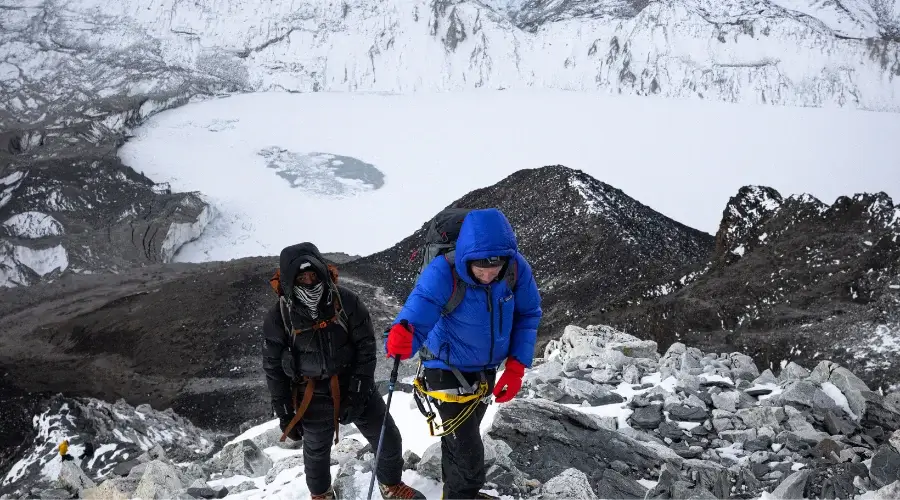
From Dingboche, our initial climb is towards the Imja valley. Witnessing the stunning Lhotse and Nuptse (mountains among the world’s ten tallest), we continue from Chukung to Island Peak Base Camp.
After walking for hours in the southeast direction on the path along the stream, we soon reach our destination. Here, we set up camp with the team’s help and let our bodies rest. A night at the base of the mountains will definitely be magical.
Island Peak Base Camp Tents:
- Shared tents with sleeping bags provided.
- No permanent facilities or bathrooms.
- Basic cooking facilities are available for meal preparation.
- No Wi-Fi or electricity.
- Hot shower is not available; outdoor camping experience.
Meal : Breakfast, Lunch and Dinner
Accommodation : Tent
Walking / Driving : 4 Hours
Day 08: Climbing Island Peak (Imja Tse) and back to Chhukung
Trek Route: Island Peak Base Camp → Island Peak (Imja Tse) Summit → Island Peak Base Camp → Chhukung
Beginning Point: Island Peak Base Camp (5080 m / 16698 ft.)
Ending Point: Chhukung (4730 m / 15519 ft.)
Lunch: Packed lunch during the climb
Island Peak Base Camp to Island Peak (Imja Tse) to Chhukung Distance: 11 km / 6.8 miles
Total Descent: 1435 meters
Ascent during the climb: 1085 meters
Overnight: Chhukung
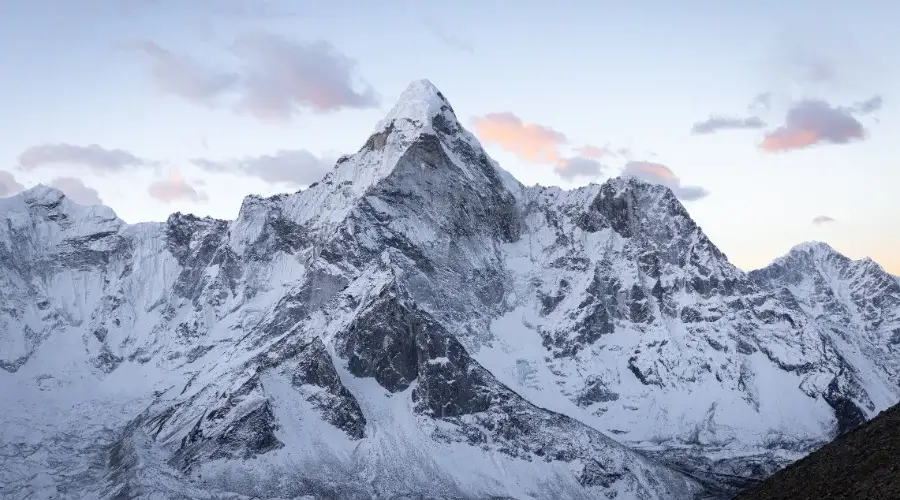
Today is the most challenging and exciting day of the entire Island Peak climbing journey. We start the day early in the morning, i.e., before sunrise.
Fully equipped, we began to hike to the summit before noon. Since the wind after midday is mighty, we plan to reach the summit before that.
The guide will assist you in the difficult section, so listen to him properly. From the peak, we can witness the breathtaking panorama of the mountain vistas. We start climbing at 4 am, even earlier, so we can reach the peak before noon.
We will tackle several technical sections and head towards the summit. The guide will help you with ropes and crampons when needed.
The views of Everest, Lhotse, Makalu, and Baruntse look amazing from here. After some moments here, we slowly walk down the tricky area and reach base camp. We walk to Chukung to spend our night in the warm tea house if possible.
Meal : Breakfast, Lunch and Dinner
Accommodation : Tea House
Walking / Driving : 11 hours
Day 09: Trek Back to Dingboche from Chhukung
Beginning Point: Chhukung (4730 m / 15519 ft.)
Ending Point: Dingboche (4410 m / 14464 ft.)
Lunch: Dingboche
Distance: 4 km / 2.5 miles
Total Descent: 320 meters
Overnight: Tea House
The trek from Chhukung to Dingboche involves a scenic journey through the Himalayas, where trekkers navigate past stunning landscapes and traditional villages.
Starting at Chhukung, the path leads you gradually uphill, crossing glacial rivers and traversing rocky terrains, ultimately arriving in Dingboche.
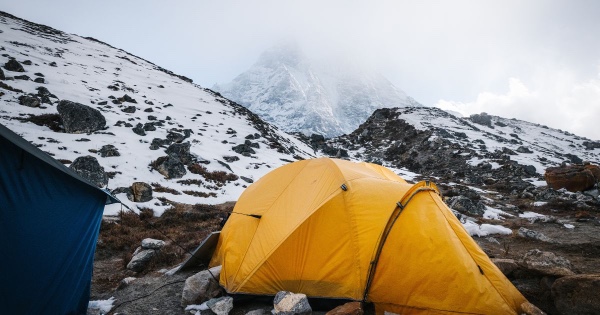
Dingboche is a charming village known for its vibrant fields surrounded by stone walls that protect crops from harsh winds. This trek typically takes about four to five hours and offers breathtaking views of the towering peaks, including Lhotse and Ama Dablam.
Meal : Breakfast, Lunch and Dinner
Accommodation : Tent
Walking / Driving : 3 hours
Day 10: Trek back to Tengboche from Dingboche
Beginning Point: Dingboche (4410 m / 14464 ft.)
Ending Point: Tengboche (3860 m / 12664 ft.)
Lunch: Somare
Dingboche to Tengboche Distance: 8 km / 5 miles
Total Descent: 550 meters
Overnight: Tengboche
You’ll follow familiar trails back through forests and past monuments before reaching Tengboche again. From Dingboche to Tengboche, the trek continues with a descent that takes you through lush forests and alongside the Imja Khola River.
After crossing the river, the trail ascends steeply through a series of switchbacks, leading to Tengboche, famous for its monastery set against majestic mountains.
The journey usually takes about four to five hours, allowing trekkers to soak in the serene atmosphere and stunning vistas.
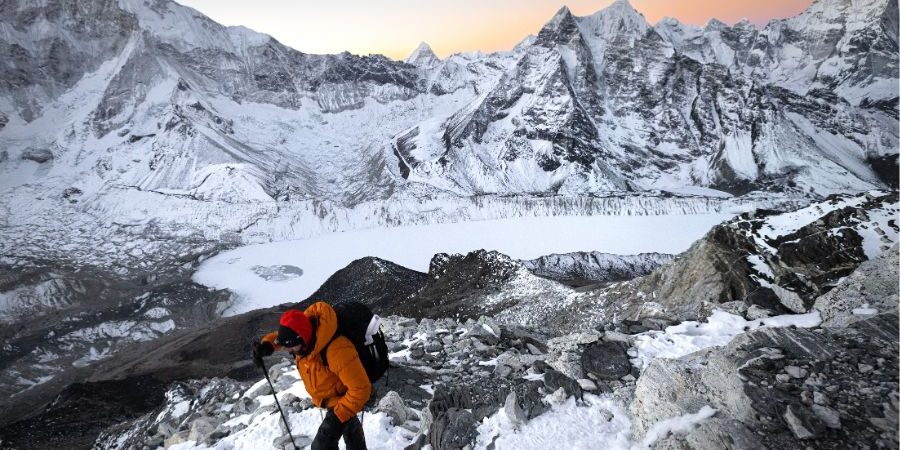
Meal : Breakfast, Lunch and Dinner
Accommodation : Tea House
Walking / Driving : 5 hours
Day 11: Trek Back to Namche from Tengboche
Beginning Point: Tengboche (3860 m / 12664 ft.)
Ending Point: Namche Bazaar (3440 m / 11319 ft.)
Distance: 6 km / 3.7 miles
Total Descent: 420 meters
Lunch: Kyanjuma
Overnight: Namche
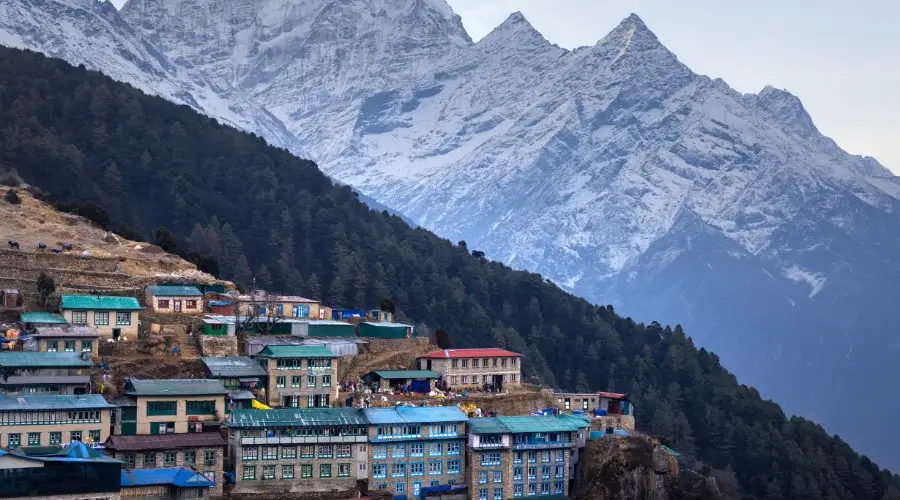
The trek down offers beautiful landscapes as you return once more to Namche Bazaar. Tengboche to Namche involves a challenging descent followed by a steep ascent back to Namche Bazaar.
This part of the trek is particularly rewarding as it provides spectacular views of Everest and other peaks.
The trail goes through pine forests and past small villages, taking approximately five to six hours to complete. Upon reaching Namche, trekkers can enjoy the vibrant atmosphere of this hub.
Meal : Breakfast, Lunch and Dinner
Accommodation : Tea House
Walking / Driving : 4 hours
Day 12: Trek Back to Lukla from Namche
Trek Route: Namche Bazaar → Monjo → Phakding → Ghat → Lukla
Beginning Point: Namche Bazaar (3440 m / 11319 ft.)
Ending Point: Lukla (2860 m/ 9383 ft.)
Lunch: Local tea house
Distance: 18 km / 11.2 miles
Total Descent: 580 meters
Overnight: Lukla
Your final day of trekking leads back down towards Lukla, where celebrations await after your successful journey. The trek from Namche to Lukla is generally easier as it follows a well-marked path that gradually descends towards Lukla.
This section offers stunning views of the Dudh Kosi River valley and surrounding mountains. It typically takes about six hours to reach Lukla, where trekkers can relax and prepare for their flight back to Kathmandu.
Meal : Breakfast, Lunch and Dinner
Accommodation : Tea House
Walking / Driving : 6 hours
Day 13: Fly back to Kathmandu from Lukla
Flight Route: Lukla → Kathmandu
Beginning Point: Lukla (2860 m/ 9383 ft.)
Ending Point: Kathmandu (1400 m/ 4593 ft.)
Distance: 136 km
Total Descent: 1420 meters
Overnight: Kathmandu
After having our breakfast, we will fly back to Kathmandu from Lukla. This ends our Island Peak Journey. After returning to kathmandu, you can enjoy the accomplishments you have achieved. Or you can also stroll around various places in Kathmandu.
Meal : Breakfast
Accommodation : Guest House
Walking / Driving : 25 min flight
Fixed Departure
| Trip Date | Trip Status | |
|---|---|---|
| 01-09-2025 | GUARANTEED | book now |
| 07-09-2025 | GUARANTEED | book now |
| 13-09-2025 | GUARANTEED | book now |
| 17-09-2025 | GUARANTEED | book now |
| 20-09-2025 | GUARANTEED | book now |
| 25-09-2025 | GUARANTEED | book now |
| 27-09-2025 | FULL | book now |
| 01-10-2025 | LIMITED | book now |
| 07-10-2025 | GUARANTEED | book now |
| 13-10-2025 | GUARANTEED | book now |
| 20-10-2025 | LIMITED | book now |
| 27-10-2025 | LIMITED | book now |
| 01-11-2025 | OPEN | book now |
| 06-11-2025 | OPEN | book now |
| 16-11-2025 | OPEN | book now |
| 24-11-2025 | OPEN | book now |
| 30-11-2025 | OPEN | book now |
| 01-12-2025 | OPEN | book now |
| 10-12-2025 | OPEN | book now |
| 15-12-2025 | OPEN | book now |
| 20-12-2025 | OPEN | book now |
| 25-12-2025 | OPEN | book now |
| 30-12-2025 | OPEN | book now |
include / exclude
Trip Cost Includes
- Private car pick-up and drop-off at all International and domestic airports.
- A professional English-speaking trekking guide during the trekking.
- Three Night Accommodation (3-star Hotel) in Kathmandu with Breakfast.
- A professional Proter for trekking and climbing with his food, accommodation and insurance.
- Breakfast, Lunch and Dinner during your trekking and expedition.
- Basic twin-sharing tea house accommodations in the mountains.
- Sagarmatha National Park permits.
- Khumbu Municipality permits.
- Island Peak permits.
- Kathmandu to Lukla and back to Kathmandu from Lukla airfare.
- Guide flight ticket.
Island Peak climbing Cost includes
- One night tent stay at the Island Peak Base Camp.
- One night tent accommodation at Island Peak High Camp.
- Breakfast, lunch and dinner during base camp and high camp, as well as tea and coffee are unlimited.
- 2 climbing Sherpas (Private guides) for 3 clients for climbing Island Peak (Imja Tse).
- Guide insurance.
The Complimentary service from The Himalayan Masters
- A -25° sleeping bag for the trip.
- Down jacket for the trip.
- Water bottles and purification tablets.
- First Aid Kit box for the trip.
- Himalayan Masters Brand Duffle Bag for the trip.
- Himalayan Masters Brand Trekking T-Shirt and Cap.
- Farewell dinner in Kathmandu by the Himalayan Masters Team.
Trip Cost Excludes
- An international flight ticket.
- Tips for climbing guides, porters and base camp staff.
- Lunch and dinner in the Kathmandu.
- Wifi, battery charging, and hot showers in the mountains.
- Travel Insurance.
- Other personal expenses.
Other things that have not been mentioned above are also on the exclusion list.
useful info
Best Time to do Island Peak Climbing
You’ll experience beautiful landscapes with blooming flowers and clear skies in spring (March, April, May). Daytime temperatures range from 15 to 17 degrees Celsius, while nights can get chilly at -10 degrees Celsius.
Autumn, on the other hand, offers stable weather and clear views of the Island Peak Himalaya. Temperatures range from 0 to 15 degrees Celsius during the day, with colder nights dropping to around -15 degrees Celsius by late November.
Avoiding the monsoon season in summer is wise, as heavy rain makes the trails muddy and dangerous—additionally, the risk of avalanches and landslides increases during this time. Winter months, December to February, are considered off-season due to extreme cold, but with proper preparation, climbing in December can be manageable, offering solitude and peaceful terrain.
Island Peak Climbing cost
The Island Peak climbing cost is $2305 per person. The price fluctuates per season since permit costs depend on the season. The Island Peak Cost includes all the accommodation costs, food, water, and permit costs while you are on the climb.
How Difficult is Island Peak Climbing?
This Island Peak climb difficulty is not a piece of cake. The long climb at 6,189m above sea level has some difficulties you cannot consider. Some previous hiking experience, excellent physical health, and a lot of determination are needed to make this island peak climb successful.
As per the Himalayan masters itinerary of 16 days, you will walk 6 to 7 hours daily. This is about 12 to 13 hours of walking with 10 to 15 kg of a backpack in rough mountain terrain. The Island Peak climb has alternative up-and-downhill routes with a few steep walks. In some parts, you might need crampons, ropes, and axes.
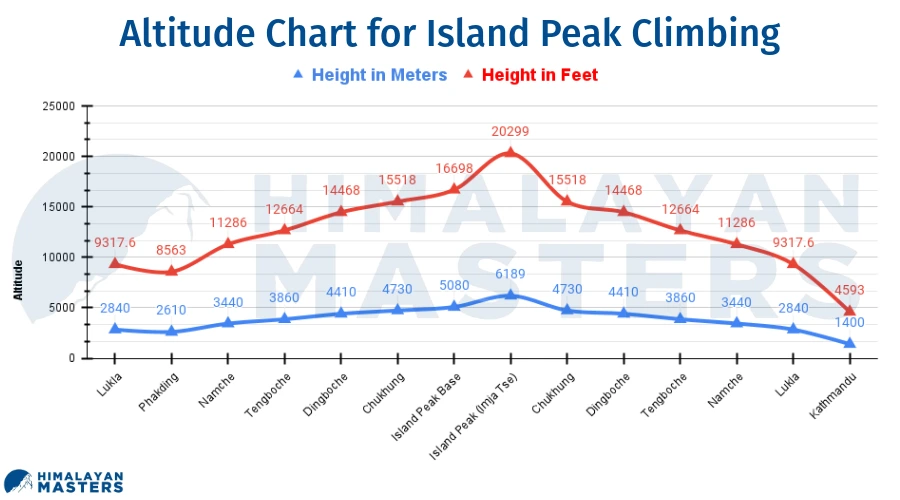
Further, the journey gets more challenging if you add climbing Mera and Island Peak. Trekking via the rugged path at Island Peak’s height of 6,189 meters means your body gets half of the oxygen from that at sea level. Cases of altitude sickness are seen in one in three people (when precaution is not taken).
Since our itinerary has a lot of rest days and only a few hours of walking per day, you will be safe in our hands. Also, people should keep themselves hydrated, avoid all kinds of alcoholic drinks, and stroll. Further, the island peak climb season also determines the island peak difficulty.
Permits to do Island Peak Climb
To climb the Island Peak Himalaya, climbers need a Nepal Mountaineering Association (NMA) Permit, a Sagarmatha National Park Entry Permit, and a Local Area Permit (Khumbu Rural Municipality Entrance permit).
NOTE: The climbing permit costs $250 per person during the spring season, $125 in Autumn, and $70 per person in winter.
Food and Accommodation during the Trip
In Kathmandu, we’ll stay in 3-star hotels on a twin-sharing basis, ensuring a comfortable start to our journey. However, options range from 3 to 5-star hotels, basic lodges, and even hostels if preferred. Single rooms are available at an additional cost but must be pre-booked due to limited availability.
Once we trek into more remote areas of Island Peak Trek, our accommodations transition to tea houses in charming villages. These tea houses offer basic facilities with twin-sharing rooms and attached bathrooms, ensuring hygiene and comfort during our stay.
As we continue Island Peak trekking, we’ll spend nights in tented camps, especially at the Island Peak Base Camp. Here, we’ll camp for two days alongside our group, immersing ourselves in the rugged beauty of the mountains.
Despite the simplicity of our accommodations, our focus remains on safety and providing the best experience possible. Meals throughout the journey include breakfast, lunch, and dinner, with various options in Kathmandu.
As we ascend altitude, we gradually transition to local dishes like Dal Bhat. Our staff ensures we receive nutritious meals to fuel our adventure ahead. Read complete food and accommodation in Everest.
Staying hydrated is crucial, especially during long treks in high altitudes. While bottled water is available, it can be pricey, particularly at higher altitudes. To overcome this, we’re encouraged to bring reusable water bottles and purification methods. Natural springs and taps along the way offer opportunities to refill our bottles, ensuring we stay hydrated throughout our expedition.
Altitude Sickness at Island Peak
Reaching the top of Island Peak Elevation, which stands at a height of Island Peak of 6189 meters, brings the excitement of high altitude. But along with this thrill comes the risk of altitude sickness. This happens when your body struggles to adapt to the changes in altitude.
Taking care as you climb is important to avoid feeling unwell. Spending nights above 3000 meters during the journey increases the chances of experiencing symptoms like headaches or dizziness.
To prevent this, you can acclimate slowly, drink plenty of water, and get enough rest. It’s also wise to consult a doctor about medication like Diamox, which can help. Your guide will assess the situation and make the right decisions if symptoms worsen.
Terrain on The Island Peak Trek
The trek begins by following the main path to Everest Base Camp Island Peak, which is well-travelled but can be rocky and uneven sometimes. Once on the mountain, you’ll encounter loose rocks and steep drops, especially as you ascend in the dark at 4 am. Hands may be needed for support as you navigate the scree and rocks.
The summit ridge is narrow and crowded, with only one fixed line to the top. Negotiating with others is necessary, and caution is required on exposed sections. Descending, especially the initial abseil from the summit ridge, requires extra care. Some climbers may need to be more confident, slowing progress.
Climbing Experience for Island Peak Summit
If you’re joining our Island Peak expedition, having prior experience with winter mountaineering is crucial. You should know how to wear crampons, use an ice axe properly, and tie into a harness on a rope.
Walking safely on snowy and icy terrain with the help of ropes is also essential. Our guides will be there to teach and assist you, so be sure to communicate your experience level to them.
On the challenging headwall section, you’ll need to ascend using a jumar and safety karabiner attached to your harness. Descending will require using a descender, so it’s vital to have practised these techniques beforehand.
The Island Peak summit ridge offers stunning views but requires concentration and composure due to steep drops on either side. Experience with ridge walking and confidence in crampons and ice axes are necessary.
Island Peak Support Team with Himalayan Masters
Before your Island Peak Climb, you can ask experienced guides and climbers for advice. When you get to Nepal, our operations manager in Kathmandu will organize everything for you. They’ll introduce you to your trek and climb guides. You can also talk to them whenever you have a signal during your Island Peak trek or climb. Our main office is always there to help, too.
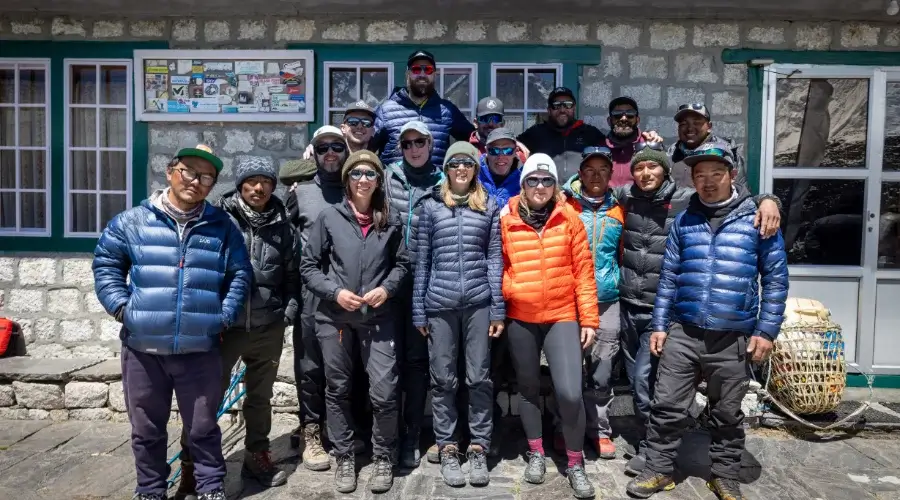
You’ll be with guides who are experts in Island Peak trekking and climbing in high places. We take care of our porters’ health and well-being. Our staff are qualified mountain pros, so they understand what it’s like to climb for the first time.
We ensure our Sherpa guides and local staff have insurance if anything goes wrong. We’ll help you prepare for your trip and advise you on staying safe at high altitudes.
If you plan to climb Island Peak Himalaya, you can talk directly to a guide who’s climbed it many times. Our office staff are friendly and knowledgeable, ready to answer all your questions.
Our company is fully insured and financially protected, so your money is safe with us. We’re set up to handle trips like this properly.
Island Peak Climb Emergency and Evacuation
In Nepal, if there’s an emergency, helicopters are often used to rescue people. There’s a sound system in place for this. Having travel insurance is important. You need to tell your insurance company where you’re going and what you’re doing.
If there’s an emergency, the team and guides will help move the injured person to a safe place and then to a helicopter, which can pick them up. Sometimes, bad weather can delay helicopter rescues, so being prepared to manage independently is essential.
In the mountains, horses are available if someone needs help coming down. They charge about $150 a day, and you must pay in cash. If you need a helicopter, your insurance company can arrange it, but you’ll need to talk to them directly and give them your policy number, name, address, and when you bought the policy.
If someone gets altitude sickness, it’s essential not to take risks. The best thing to do is to descend to a lower altitude. Going higher can make things worse quickly and can lead to severe problems like fluid buildup in the brain or lungs. Even if you take medicine for altitude sickness, it’s still best to go down.
Incidents are rare, especially in well-supported areas like Island Peak Himalaya in Nepal. If help is needed, there’s a rescue centre near Pheriche, near Chukkung. An Everest Base Camp Helicopter will be ready for you.
Kit and Equipment for Climbing
Climbing Gear
- Crampons
- Ice Axe
- Alpine Climbing Harness
- Ascender
- Descender (Figure-8)
- Carabiners (4: 2 locking, 2 non-locking)
- Rope
- Helmet
- Tape Sling
- Mountaineering Boots
Clothing
- Upper Body
- Waterproof Shell Jacket
- Insulated Down Jacket
- Fleece Jacket
- Base Layer Tops (2 sets)
- Lower Body
- Waterproof Shell Pants
- Softshell Climbing Pants
- Base Layer Leggings (2 sets)
Headwear
- Warm Hat
- Balaclava or Neck Gaiter
- Sunglasses (UV Protection)
- Ski Goggles
Handwear
- Liner Gloves (2 pairs)
- Fleece Gloves
- Mountaineering Gloves
- Expedition Mittens
Footwear
- Heavy Wool Socks (3 pairs)
- Lightweight Inner Socks (3 pairs)
- Snow Gaiters
Personal Items
- Sleeping Bag (rated for 0°F/-18°C)
- Inflatable Sleeping Pad
- Water Bottles (2)
- Small Travel Bag/Duffel Bag
- Pee Bottle/Pee Funnel (for women)
Accessories
- Headlamp (water-resistant preferred)
- Trekking Poles
- Swiss Army Knife or Multi-tool
- Toiletry Bag
- Sunscreen & Lip Balm (SPF)
Specific Training for Island Peak Himalaya
Island Peak Climb is a challenging adventure that requires specific training due to its ever-changing terrain and route. Each season brings different conditions, making it unpredictable. Climbing can become more difficult or easier with melting ice and varying snow levels.
Preparing for anything is crucial, especially as the route to the Island Peak summit has become more direct. Physical fitness is key, as you may encounter long summit days without rest, deep snow, or steep ice walls. Safety is paramount, and professional guidance is recommended to navigate the challenges and minimize risks.
Weather Information of Island Peak
Island Peak Himalaya sits in Nepal’s Solu-Khumbu region, famous for its unpredictable weather. When climbing Island Peak altitude, the conditions vary depending on the time of year. Before the monsoon season (March to May), the weather is moderate, but still, expect sudden strong winds and snow.
It gets colder after the monsoon (September to November), and there’s more chance of snow. At the Base Camp, temperatures range from freezing to 10°C during the day and drop below freezing at night. On the mountain itself, it’s even colder, especially with wind chill.
Mera Peak Vs. Island Peak Summit, which is more difficult?
Mera Peak is considered an easier climb than the Island Peak Climb. Even though Mera Peak is taller, the path to the top is straightforward, with no tricky parts – it’s like taking the easiest route on a mountain. On the other hand, Island Peak Himalaya involves more challenges.
Deep cracks in the ice called crevasses require climbers to cross, sometimes using ladders. There are also steep parts where climbers use ropes fixed to the mountain to help them up. Climbing Mera Peak doesn’t require much experience, but the Island Peak Tour requires some basic mountaineering skills.
ATM on the Island Peak Trek
The only ATMs you will find are up to Namche Bazar and Kathmandu. In Namche Bazar, there are few banks and ATMS. But you can not rely solely on the items at such high altitudes. Sometimes, the internet might not work, so you need to be prepared with extra cash for the trek from Kathmandu itself.
Money Exchange
You can exchange money during the trek in Kathmandu. Thamel is the tourist hub of Kathmandu, where you will find various tourist money exchange spots. Most places have the same money exchange rate as the government has decided, but it would be best if you were careful.
Things to Avoid/not Packed
If you have many extra things you do not need for Island Peak climbing in Nepal, you can store them in the Himalayan Masters. This will help you reduce the extra cost the hotel charges for storing the necessary things.
Electricity & Battery Recharge
During your trek to Island Peak, electricity is available only up to Chhukung. Once you go beyond that, the base camp on an upward climb has no access to electricity or Wi-Fi connectivity. Lack of connectivity may be a problem for trekkers who depend on electronic devices for navigation or communication.
Thus, it is always a good idea to carry a portable charger and a power bank since they will keep all your devices charged throughout the trek. Carrying a universal adapter can make life easier, as you can charge all sorts of equipment with as little fuss as possible, making life easier for you to deal with when you go out on the trail.
Water on Island Peak
Fortunately, trekkers do not need to be too concerned with water, as Himalayan Masters provides each trekker with free water purification tablets that ensure trekkers’ water is safe to drink. Even though boiled water is available at the teahouses, you can treat any water you find in nature with purification tablets. You should drink 3-4 litres of water daily to stay hydrated.
Communication on Island Peak Trek
Local SIM Card/ Landline/ Postal Services / Walkie Talkie
When you arrive in Nepal, purchasing a local SIM card for the trek is better. It keeps you connected with your closest ones during the trek. Some significant areas of the trails have good network coverage; however, you cannot rely on it at times as it will be spotty most of the time.
You can also contact from your hometown using the landline services provided by some of the teahouses. The walkie-talkies will also be helpful during group communication on a trek since everyone will be in contact without needing to depend on the cellular system.
Wi-Fi/Internet
At the larger villages, such as Chhukung, Wi-Fi is accessible, but as one proceeds upwards to the base camp, it becomes sparser. Most of the lodges would have some internet service at specific sums of money, but it is wiser to download anything that one would want or need for entertainment first before leaving Chhukung.
Safety and Security
The company, Himalayan Masters, will do a lot for your safety and security. We have a very professional and experienced licensed trekking guide who will help you find routes and teach you how to be patient. Also, it would help if you carried your travel insurance for extra safety on the trek so that it can cover any inconvenience caused.
Guide Versus Independent Trek
Trekking with a guide is advisable for safety and route-finding purposes in most places. A guide has local knowledge and understands the weather conditions. They also help when an emergency arises so that a trekker is well attended to during the journey.
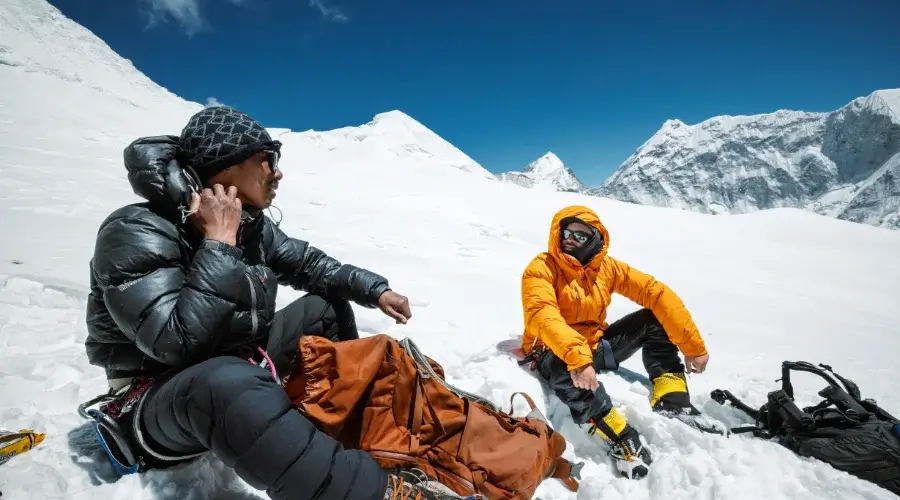
Porters Versus No Porter
Using porters significantly improves the trekking experience, as one does not have to bear the heavy luggage. Trekkers can enjoy views worldwide and acclimate appropriately without the weight of heavy backpacks. If you will not hire a porter, it is highly recommended that you keep lighter and only the most important things to simplify your trek.
Tips on Hiring a Porter
When you hire a porter for your trekking, remember to ask about his experience and physical fitness. It is highly recommended that the terms be discussed clearly in advance, including payment rates and areas of responsibility. This way, you will establish mutual understanding, which may help during the trek work process.
Tipping Culture for Guides and Porters
Tipping in Nepal is part of the trekking culture. The rate suggested is 10 to 15% of the total cost of the trek to guides and porters based on their service quality.
Alternative Trekking Routes for Island Peak
Routes like Gokyo Valley or the Three Passes trek offer great panorama views and varied landscapes. They also avoid some busier trails tourists take. The option of less crowded paths or different experiences draws people to these routes.
Extending the Climb
If you want to extend the Island Peak climbing, you can extend it with Mera Peak and Lobuche East Peak climbing. But if you want to explore outside the Everest region, you can trek to the Annapurna Region of Nepal.
But if you want to chill and stroll around, you can choose National Park tours or Pokhara daycations.
How to Book an Island Peak Trip?
You can book your Island peak trip with Himalayan Masters via their website booking form or by email at [email protected].
How Can I Book a Trip at the Last Minute?
Local agencies in Kathmandu and other online platforms offering flexible itineraries can be used to book last-minute treks. Still, it is best to get in touch as early as possible to ensure availability during peak seasons.
Why Choose Himalayan Masters?
Himalayan Masters has extensive experience providing trekking support through experienced guides. They emphasize safety and acclimatization strategies, maximizing the chances of successful summit attempts and allowing trekkers to have a truly enriching experience in the Himalayas.
Feedback/Review
Himalayan Masters seek warm reviews from the climbers and trekkers they have worked with. We want a team that would improve on any inconvenience or services we may have provided.
Reviews
I contacted Sandip from Himalayan Masters about a trip to Nepal in early 2022. I was hopeful of doing Everest base camp and maybe a climb of a 6000m peak. From the second we first connected Sandip cared so much about my trip and my needs.
After arriving in Nepal Sandip greeted me at the airport and gave me a beautiful flower necklace. He dropped me at my hotel and made sure I checked in okay. He was always a message away if I needed anything.
I started my trek 4 days after arriving and my guide was Govinda. Govinda was an amazing guide with awesome English. Govinda and I instantly connected and over the next 17 days, we had an absolute ball. Over 17 days I don’t have a smile left my or Govinda’s face.
My trip to the Himalayas was Truly life-changing. I would recommend anyone considering a trip to Nepal/Bhutan/Tibet to contact Sandip from Himalayan Masters for a great value package.
I would also recommend Govinda as a guide if you’re looking for a friendly fun loving human who genuinely cares about you and your needs. I’m lucky enough to call Govinda my brother now 🙂
Thank you Himalayan Masters and I will be back!
Lachlan NorrisAustralia
FAQs
What is the cost of Island Peak climbing?
With Himalayan Masters, climbing Island Peak typically costs around $2305, including visas, permits, camps, food, equipment, lodging, guides, and porters. The Island peak permit costs less than other climbing peaks in Nepal because it doesn’t require an extraordinary mountain ascent.
How technical is Island Peak to Climb?
How long does it take to climb Island Peak Climbing?
How difficult is it to climb Island Peak?
Is Island Peak the top of Everest?
Do you need oxygen for Island Peak?
What is the oxygen level at Island Peak?
What do you need to know about Island Peak?
Can a beginner climb Island Peak?
Which is harder, Mera Peak or Island Peak?
Can you climb Island Peak without a guide?
What is the success rate of the Island Peak?
Which is the hardest of 3 peak challenges?
Which is the best trekking organization for Island Peak?
How steep is Island Peak?
Which is the easiest Peak to climb?
When to climb Island Peak?
Speak to an Expert





Sandip Dhungana
Nepal 🇳🇵
Whatsapp: +977-9823636377
Speak to an Expert





Sandip Dhungana
Nepal 🇳🇵
Whatsapp: +977-9823636377



